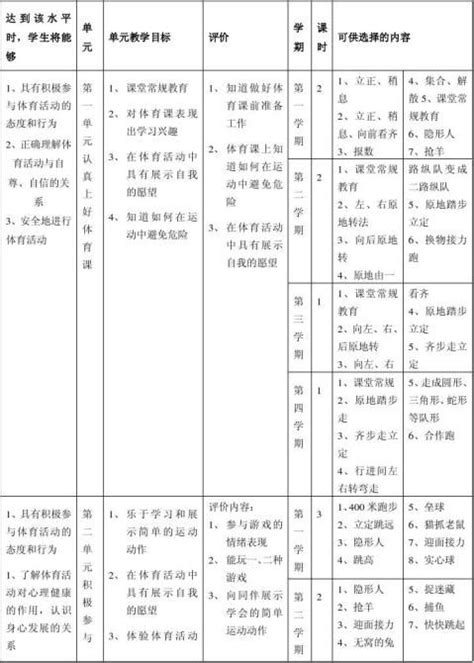三四年级体育教学进度
Title: Designing an Effective Physical Education Curriculum for Third and Fourth Graders
Physical education is crucial for the holistic development of children, particularly in their formative years. A welldesigned curriculum not only promotes physical fitness but also enhances cognitive skills, social interactions, and emotional wellbeing. Here's a comprehensive plan tailored for third and fourthgrade students:
I. Introduction to Physical Education:
Objective:
Introduce the importance of physical activity for overall health and wellbeing.
Activities:
1. Classroom discussion on the benefits of physical exercise.
2. Short videos or presentations showcasing famous athletes as role models.
3. Warmup exercises to kickstart the session.
II. Fundamental Movement Skills:
Objective:
Develop basic locomotor and manipulative skills essential for various sports and activities.
Activities:
1. Running, jumping, hopping, and skipping drills.
2. Throwing, catching, kicking, and striking exercises using ageappropriate equipment.
3. Fun games like relay races, tag, and balloon volleyball to practice these skills.
III. Sports and Games:
Objective:
Introduce a variety of sports and games to enhance coordination, teamwork, and sportsmanship.
Activities:

1. Rotating through different sports such as soccer, basketball, tennis, and hockey.
2. Modified games with simplified rules to accommodate skill levels.
3. Emphasis on fair play, cooperation, and respect for opponents.
IV. Fitness and Health Awareness:
Objective:
Instill the importance of regular exercise and healthy lifestyle habits.
Activities:
1. Fitness circuits incorporating cardiovascular, strength, and flexibility exercises.
2. Discussions on nutrition, hydration, and the effects of exercise on the body.
3. Setting personal fitness goals and tracking progress throughout the year.
V. Outdoor Adventures:
Objective:
Explore outdoor activities to connect with nature and promote environmental stewardship.
Activities:
1. Nature walks, scavenger hunts, and orienteering challenges.
2. Low ropes courses to build confidence, problemsolving, and teamwork skills.
3. Environmental projects like planting trees or cleaning up the school grounds.
VI. Creative Movement and Dance:
Objective:
Foster selfexpression, creativity, and rhythmic awareness through dance and movement.
Activities:
1. Dance routines incorporating various styles such as hiphop, ballet, and folk dances.
2. Partner/group choreography sessions to encourage collaboration and communication.
3. Opportunities for students to showcase their performances in school events.
VII. Assessment and Evaluation:
Objective:
Assess students' progress and understanding of concepts covered in the curriculum.
Methods:
1. Informal observation during class activities and games.
2. Skillspecific assessments using rubrics for running, throwing, etc.
3. Student selfassessment and reflection on personal growth and achievements.
VIII. Integration with Other Subjects:
Objective:
Incorporate physical education themes into other areas of the curriculum for a holistic learning experience.
Examples:
1. Math: Measurement of distances in running/jumping events.
2. Science: Study of the human body and its response to exercise.
3. Language Arts: Writing reflective essays on favorite sports or outdoor experiences.
IX. Parent and Community Involvement:
Objective:
Engage parents and the community in supporting children's physical activity and wellbeing.
Initiatives:
1. Family fitness nights with interactive games and activities.
2. Workshops on healthy cooking or outdoor recreation for parents.
3. Collaborations with local sports clubs or fitness centers for additional resources.
X. Conclusion:
A wellrounded physical education curriculum for third and fourth graders not only promotes physical fitness but also cultivates essential life skills such as teamwork, resilience, and a lifelong appreciation for an active lifestyle. By incorporating a variety of activities, fostering a positive learning environment, and involving stakeholders, educators can create an enriching experience that lays the foundation for a lifetime of health and wellness.
This curriculum aims to cater to the diverse needs and interests of third and fourthgrade students while providing them with the knowledge, skills, and motivation to lead active and healthy lives.



